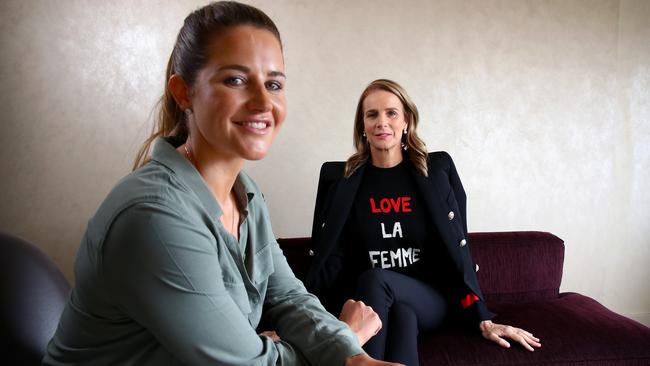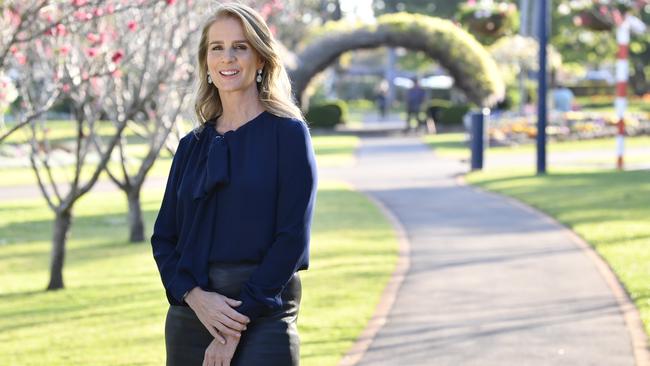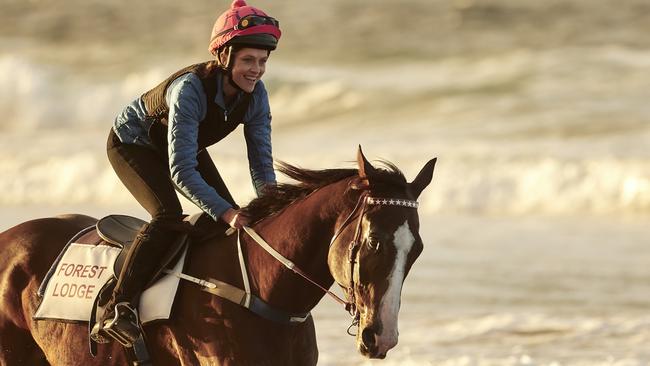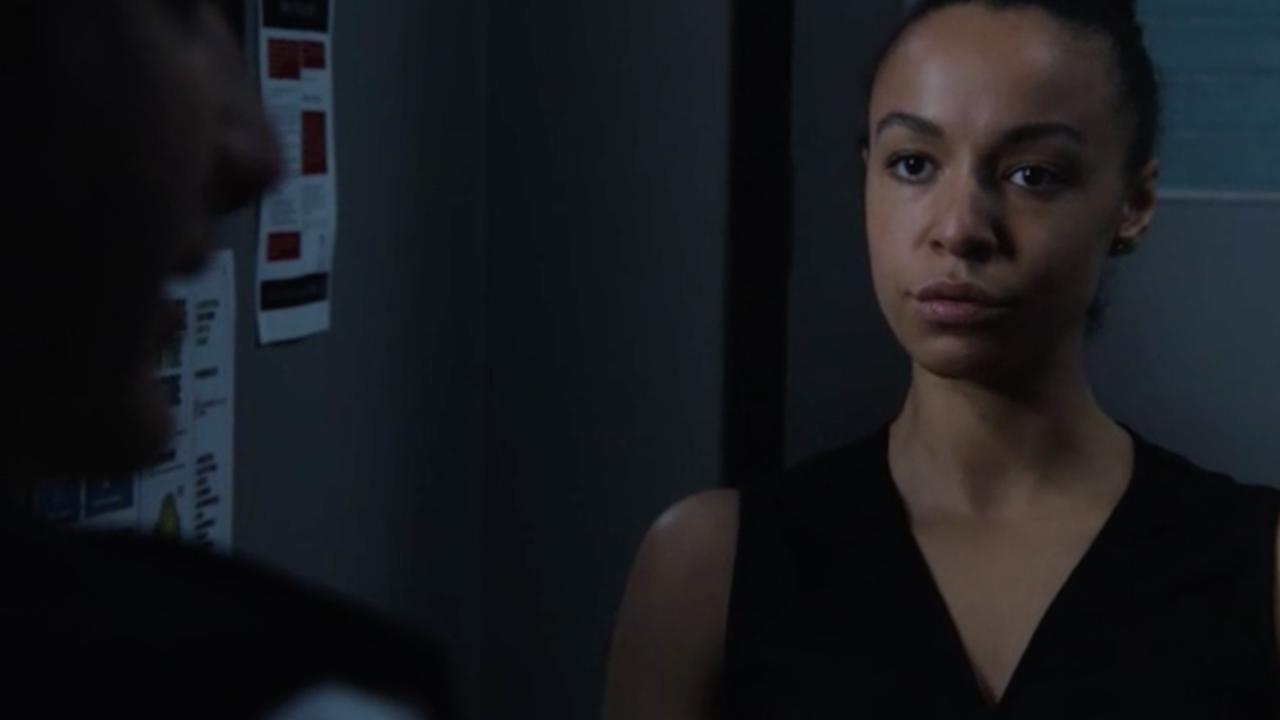How Rachel Griffiths became a horse owner
Before Ride Like A Girl, Rachel Griffiths knew little about horse racing. Now she co-owns a winning filly with Michelle Payne and champion surfer Layne Beachley and it’s eyeing Royal Ascot.
Entertainment
Don't miss out on the headlines from Entertainment. Followed categories will be added to My News.
Despite growing up in the home of the Melbourne Cup, Rachel Griffiths was never really terribly fussed about horse racing.
But all that changed in 2015, when Michelle Payne became the first woman to win the race that stops the nation on board 100-1 shot Prince Of Penzance.
The Oscar-nominated actor was at a barbecue when the Ballarat jockey crossed the line in first place, embraced her strapper brother Stevie, who has Down syndrome, and then famously told the doubters to “get stuffed” if they didn’t think women were good enough.
Griffiths, director of the new Payne biopic Ride Like a Girl, freely admits that at the time she had no idea that women were jockeys, let alone that there was one in the race.
“I had come from such a low point of knowledge so in that moment my brain woke up in so many ways,” Griffiths says in a Melbourne hotel room, the morning after the movie’s star-studded world premiere.

As if that moment wasn’t dramatic enough, the deeper the Oscar-nominated actor, best known for US TV roles in Six Feet Under and Brothers and Sisters, dug into the Payne story, the more her mind was blown.
Once she had discovered that Payne was the youngest of ten children from a respected, Catholic, racing family, her mother had died when she was young, her sister Brigid died after a racing accident and Michelle herself had nearly been killed in a fall, Griffiths knew she had found the perfect story for her first feature film as director.
“It’s the most dangerous sport in the world that we allow women and men equal opportunity to kill themselves,” says Griffiths.
“I just found that so exciting and then the moment that Stevie ran out and they hug and they go ‘that’s Michelle’s brother, the strapper’. I’d missed the barrier draw, I hadn’t seen any of that, I didn’t really care and then I started Googling and it was ‘oh my God, she’s one of ten, her mother died’ and I just knew it was a huge breakthrough moment and I am not sure if everyone in the racing industry knew just how significant it is.”
READ MORE:
BROOKE SATCHWELL ON MR INBETWEEN’S RUNAWAY SUCCESS
WHY ELLA HOOPER AGREED TO GO TOPLESS ON TV
THE EMERSON NIGHTCLUB SITE SOLD
And it wasn’t just Payne’s journey overcoming rampant sexism in the racing world that appealed to Griffiths, who knew she wanted her first film to be a “girl’s coming of age story”. As she discovered more about horseracing itself, it occurred to her that it embodied some admirable Australian characteristics and it’s firmly the fillies rather than the frocks that have piqued her interest.
Having never been especially “fashion obsessed”, Griffiths is now part of an all-female syndicate with trainer Payne, Ride Like a Girl producer Susie Montague, champion surfer Layne Beachley, some of Payne’s Ballarat mates and “a billionaire” (among others), that owns three-year-old filly Sweet Rockette, which has had one win from her five starts, $104,700 in prize money and is eyeing Royal Ascot next year.

“I don’t think it’s surprising that our best sports stories have been at the track because Aussies celebrate a bit of a lark, the battler and also — and this it what I have come to love about racing — it’s where the bush comes to the city,” Griffiths says.
“We are becoming more and more polarised with what we in the city think and feel and how the country think we feel about them — but at the track we all come together. And it’s never mattered that you are Catholic … you could get into the Turf Club as a Jew or a Catholic, we’re all welcome. And there are not many places really left where that egalitarianism is still there.”
Excited as Griffiths was about the Michelle Payne story — she had to overcome the not insignificant obstacle of the down-to-earth, reserved country jockey herself not being terribly interested in having her story immortalised on the big screen.
Indeed, even at the world premiere, the dressed-to-the-nines Payne admitted that, all things being equal, she’d still probably rather that the film didn’t exist.
Griffiths said she “stalked” Payne to get her — and her even more reluctant family — on board, waiting in line at a Sydney race meeting to meet her and talking up the idea to her in the Chairman’s Club at Royal Randwick.
“I said I wanted to make a beautiful family film — a PG, feminist, sports film — that I will watch with your whole family and I promise they won’t want to punch either of us in the face,” Griffiths says.
“And I think that won her over. She was my key stakeholder, as were the Payne families, and my No. 1 job was to do no harm.”

Griffiths also knew the kind of film that she wanted to make. Having been told by an Australian film industry figure that if she was going to make a film with a female lead, it would need to be one that audiences would cheer for, and mindful that the project would dominate four years of her life, she “didn’t want to make a film that people didn’t want to see”.
“I wasn’t interested in establishing myself as an auteur director,” she says.
“I felt very much a custodian of a great Australian story, I was passionate about making a PG, almost matinee, film. It’s not cool and I don’t want it to be cool. I want it to play in the bush, I want it to play in the cities. I want it to play for women to bring their mothers and their daughters to. I want men to be surprised by it.”
But although Griffiths wanted women in particular to be inspired by Payne’s feats, she also wanted to illustrate that the flipsides of drive and ambition can be ruthlessness and selfishness. The director reckons that Payne is probably not too comfortable with the scenes in which she is charged with dangerous riding and the moment where brother Stevie asks her what will happen if she dies.
Indeed, mother of three Griffiths recognised the same trait in herself in taking on the monumental task of directing Ride Like a Girl.
“That’s that moment of selfishness that people who want to do extraordinary things, it gets to a point where that drive and desire and dream comes before anyone,” she says.
“That’s just the truth of it. Whether that’s directing, and my kids didn’t see me for a year, or her winning the Melbourne Cup, or climbing Mount Everest, there is a point of selfishness where we who dare greatly or strive, will put ourselves and our dream before others and I thought that moment was really important to have.”

Serendipitously, and appropriately for the story, Griffiths was also the beneficiary of Screen Australia’s Gender Matters initiative, which prioritised funding for projects with at least half of the key creative roles occupied by women.
While she’s reluctant to call Ride Like a Girl a #MeToo film — “but there are elements in there” — she believes such programs are important for the local and global film industry and hopes they will be rewarded and embraced at the box office so they can continue.
“I don’t think there are enough films that really celebrate women doing unconventional things and I think there is a huge appetite,” she says.
“It may inspire women to become jockeys, but more importantly I think it inspires girls who have unconventional dreams that maybe are in more male dominated areas to pursue them, but also that they have to have the persistence, the resilience, the stickiness. They can’t be snowflakes, they are going to run into dickheads and be told they can’t do stuff. To hold on to a dream you have to be tenacious and then maybe young girls seeing me direct it and having three female producers is also part of that ‘you can’t be what you can’t see’.”
Ride Like a Girl is now screening.



